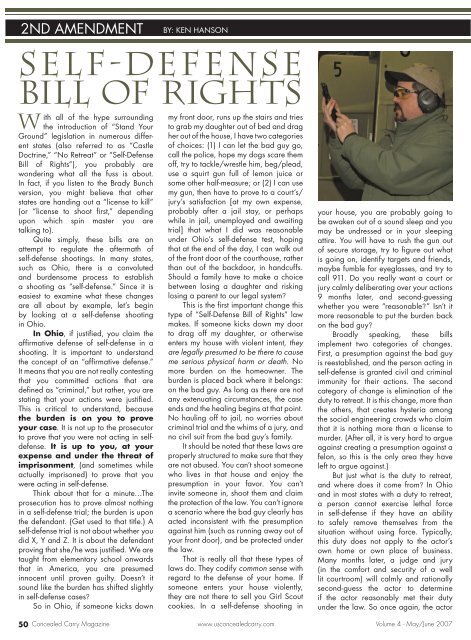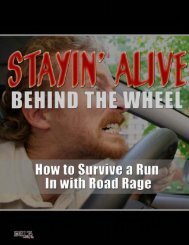2ND AMENDMENTBy: KEN HANSONith all of the hype surroundingthe introduction of “Stand YourGround” legislation in numerous differentstates (also referred to as “CastleDoctrine,” “No Retreat” or “Self-DefenseBill of Rights”), you probably arewondering what all the fuss is about.In fact, if you listen to the Brady Bunchversion, you might believe that otherstates are handing out a “license to kill”(or “license to shoot first,” dependingupon which spin master you aretalking to).Quite simply, these bills are anattempt to regulate the aftermath ofself-defense shootings. In many states,such as Ohio, there is a convolutedand burdensome process to establisha shooting as “self-defense.” Since it iseasiest to examine what these changesare all about by example, let’s beginby looking at a self-defense shootingin Ohio.In Ohio, if justified, you claim theaffirmative defense of self-defense in ashooting. It is important to understandthe concept of an “affirmative defense.”It means that you are not really contestingthat you committed actions that aredefined as “criminal,” but rather, you arestating that your actions were justified.<strong>This</strong> is critical to understand, becausethe burden is on you to proveyour case. It is not up to the prosecutorto prove that you were not acting in selfdefense.It is up to you, at yourexpense and under the threat ofimprisonment, (and sometimes whileactually imprisoned) to prove that youwere acting in self-defense.Think about that for a minute…Theprosecution has to prove almost nothingin a self-defense trial; the burden is uponthe defendant. (Get used to that title.) Aself-defense trial is not about whether youdid X, Y and Z. It is about the defendantproving that she/he was justified. We aretaught from elementary school onwardsthat in America, you are presumedinnocent until proven guilty. Doesn’t itsound like the burden has shifted slightlyin self-defense cases?So in Ohio, if someone kicks downmy front door, runs up the stairs and triesto grab my daughter out of bed and dragher out of the house, I have two categoriesof choices: (1) I can let the bad guy go,call the police, hope my dogs scare themoff, try to tackle/wrestle him, beg/plead,use a squirt gun full of lemon juice orsome other half-measure; or (2) I can usemy gun, then have to prove to a court’s/jury’s satisfaction [at my own expense,probably after a jail stay, or perhapswhile in jail, unemployed and awaitingtrial] that what I did was reasonableunder Ohio’s self-defense test, hopingthat at the end of the day, I can walk outof the front door of the courthouse, ratherthan out of the backdoor, in handcuffs.Should a family have to make a choicebetween losing a daughter and riskinglosing a parent to our legal system?<strong>This</strong> is the first important change thistype of “Self-Defense Bill of Rights” lawmakes. If someone kicks down my doorto drag off my daughter, or otherwiseenters my house with violent intent, theyare legally presumed to be there to causeme serious physical harm or death. Nomore burden on the homeowner. Theburden is placed back where it belongs:on the bad guy. As long as there are notany extenuating circumstances, the caseends and the healing begins at that point.No hauling off to jail, no worries aboutcriminal trial and the whims of a jury, andno civil suit from the bad guy’s family.It should be noted that these laws areproperly structured to make sure that theyare not abused. You can’t shoot someonewho lives in that house and enjoy thepresumption in your favor. You can’tinvite someone in, shoot them and claimthe protection of the law. You can’t ignorea scenario where the bad guy clearly hasacted inconsistent with the presumptionagainst him (such as running away out ofyour front door), and be protected underthe law.That is really all that these types oflaws do. They codify common sense withregard to the defense of your home. Ifsomeone enters your house violently,they are not there to sell you Girl Scoutcookies. In a self-defense shooting inyour house, you are probably going tobe awaken out of a sound sleep and youmay be undressed or in your sleepingattire. You will have to rush the gun outof secure storage, try to figure out whatis going on, identify targets and friends,maybe fumble for eyeglasses, and try tocall 911. Do you really want a court orjury calmly deliberating over your actions9 months later, and second-guessingwhether you were “reasonable?” Isn’t itmore reasonable to put the burden backon the bad guy?Broadly speaking, these billsimplement two categories of changes.First, a presumption against the bad guyis reestablished, and the person acting inself-defense is granted civil and criminalimmunity for their actions. The secondcategory of change is elimination of theduty to retreat. It is this change, more thanthe others, that creates hysteria amongthe social engineering crowds who claimthat it is nothing more than a license tomurder. (After all, it is very hard to argueagainst creating a presumption against afelon, so this is the only area they haveleft to argue against.)But just what is the duty to retreat,and where does it come from? In Ohioand in most states with a duty to retreat,a person cannot exercise lethal forcein self-defense if they have an abilityto safely remove themselves from thesituation without using force. Typically,this duty does not apply to the actor’sown home or own place of business.Many months later, a judge and jury(in the comfort and security of a welllit courtroom) will calmly and rationallysecond-guess the actor to determineif the actor reasonably met their dutyunder the law. So once again, the actor50 <strong>Concealed</strong> <strong>Carry</strong> Magazine www.usconcealedcarry.comVolume 4 - May/June 2007
(not the prosecutor), at the actor’s ownjeopardy and expense, has the burden ofproof to establish that they could not runaway. If the actor cannot make this casemany months removed from the chaos ofthe encounter, then the actor is ruinedfor life.Given the incredible stakes beingplayed for, there must be a careful,well thought out history behind theduty to retreat, right? There is if youlook to 16th century England andearlier. <strong>This</strong> occurred during a time inwhich self-defense was not even widelyrecognized, but rather, largely lumpedinto “excusable” homicides wherein theactor would be convicted and then civillyforfeit his property in order to obtaina pardon.That’s right, the duty to retreat comesfrom the days of flintlocks and swords,not Glocks and spring knives. Thecase law talks about highwaymen andhorse chases, not home invasions andcarjackings. As the Minnesota SupremeCourt stated: “The doctrine of ‘retreatto the wall’ had its origin before thegeneral introduction of guns... It wouldbe good sense for the law to require inmany cases, an attempt to escape fromhand-to-hand encounter with fists, clubs,and even knives...while it would be rankfolly to so require when experiencedmen, armed with repeating rifles, faceeach other in an open space, removedfrom shelter, with intent to kill or do greatbodily harm.” State v. Gardner, (1905)104 N.W. 971.If you look at the early U.S. SupremeCourt cases on self-defense, the duty toretreat was soundly rejected. In what iswidely considered the first Supreme Courtcase to do so, Beard v. United States,(1895) 158 U.S. 550, Justice Harlanstated for a unanimous Supreme Court:“[Beard] was not obliged to retreat, nor toconsider whether he could safely retreat,but was entitled to stand his ground, andmeet any attack upon him with a deadlyweapon, in such a way and with suchforce as, under all the circumstances,he, at the moment, honestly believed,and had reasonable grounds to believe,were necessary to save his own life, or toprotect himself from great bodily injury.”Nearly 30 years later, one of our mostcelebrated jurists, Oliver Wendell HolmesJr., examined the absurdity of allowinga jury to second-guess someone actingin self-defense. Once again reaffirmingthat there was no duty to retreat fromanywhere that a victim has a right to be,he stated. “If a man reasonably believesthat he is in immediate danger of deathor grievous bodily harm . . . he maystand his ground…. [d]etached reflectioncannot be demanded in the presence ofan uplifted knife.” Brown v. United States,(1921) 256 U.S. 335.Early Ohio law was alsocontemptuously dismissive of the conceptof running away. As stated in Erwin v.State, (1876) 29 Ohio St. 186: “[T]helaw, out of tenderness for human lifeand the frailties of human nature, willnot permit the taking of it to repel a meretrespass, or even to save life, where theassault is provoked; but a true man,who is without fault, is not obliged to flyfrom an assailant, who, by violence orsurprise, maliciously seeks to take his lifeor do him enormous bodily harm.” <strong>This</strong>was repeatedly the case in a majority ofstates at the time. As Richard MaxwellBrown stated on page 5 in his excellentwork: No Duty to Retreat: Violence andValues in American History and Society(1991), “Americans rejected such Englishcowardice just as they rejected Englishrule; thus, a majority of Americansgained the right to stand their groundand defend themselves as their fledglingcountry gained its independencefrom England.”It will do no good to examine thereasoning behind the shift away from“stand your ground” to “duty to retreat”in detail, and this article has probablyalready taxed the reader’s patiencewith legal citations. Whether we want toblame liberal activism, the wide adoptionof the Model Penal Code, laziness onthe part of prosecutors and judges, ora society that is willing to engage inmeaningful litigation over how manycable channels a prisoner is entitled to,the fact remains that our legal systemhas now “progressed” to the adoption of16th century legal doctrine.In this day of senseless shootings,carjacking, gang “wilding” attacks andall other horrors we see on the nightlynews, the more appropriate examinationis whether our modern day crimeenvironment allows us, with a straightface, to require the law-abiding citizento prove they couldn’t outrun a bullet.If a loved one is attacked by a repeatoffender who has spent the last 2 years inprison working out with weights for lackof anything better to do, do you want thatloved one to have to prove to a jury, 9months after the fact, that they couldn’thave reasonably gotten away?Before you dismiss the aboveanalogies and instead rely on commonsense alone to acquit you, keep in mindthe fact that Ohio is the state that recentlyinstructed a jury that someone has a dutyto retreat from a locked prison cell, andit was only the Ohio Supreme Courtthat finally ruled that someone couldn’tretreat from a locked prison cell. State v.Cassano, (2002) 96 Ohio St. 3d 94.Still feel like playing those odds,or should we just remove that questionfrom the discussion entirely? Having triedcases from both the prosecution anddefense tables, I’ll sleep soundly doingaway with the duty to retreat.Ken Hanson is an Ohioattorney active in gunrights litigation andlegislation, and is theauthor of The OhioGuide to FirearmLaws. Ken is also anNRA certified instructorand is certified byUtah BCI as a UtahCCW instructor. Ken’scompany, Center Mass Ltd., possessesa Type 01 FFL and is a direct dealerfor several manufacturers. Ken giveslegal presentations for several differentCentral Ohio CCW trainers/ranges,including: Laura’s Pistol Shooting, Ltd.;The Powder Room; Blackwing ShootingCenter; On the Defense, LLC; and RightDefense, LLC.877-677-1919CALLOR VISIT <strong>US</strong> ONLINEwww.usconcealedcarry.com<strong>Concealed</strong> <strong>Carry</strong> Magazine, <strong>US</strong>CCA and Delta Media, LLC arenot responsible for mishaps of any kind which may occur from useof published firearms information, equipment recommendations,tactics and training advice or from recommendations by staffor contributing writers. <strong>Carry</strong>ing a concealed weapon can bevery dangerous if you are not well trained and familiar withthe weapon you carry. Now don’t get us wrong, it’s not thegovernment’s job to tell you how much training you need! It isyour responsibility as an armed citizen. Notice: Some advertisementsmay concern products that are not legally for saleto California residents or residents in other jurisdictions. Ifthis bothers you, GET INVOLVED! Support the bill of rightsand vote for folks that believe in the natural born right to selfdefense.No advertised or reviewed item is intended for salein those states, or in those areas where local restrictions maylimit or prohibit the purchase, carrying or use of certain items.Check local laws before purchasing. Mention of a product orservice in advertisements or text does not necessarily mean that ithas been tested or approved by <strong>Concealed</strong> <strong>Carry</strong> Magazine,<strong>US</strong>CCA or Delta Media, LLC.Volume 4 - May/June 2007 www.usconcealedcarry.com<strong>Concealed</strong> <strong>Carry</strong> Magazine 51
















